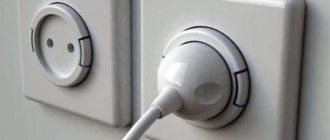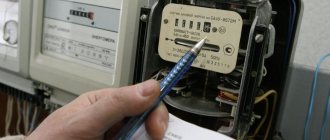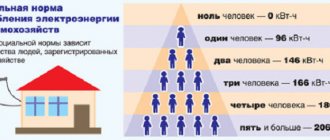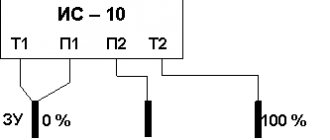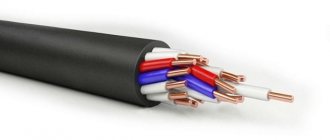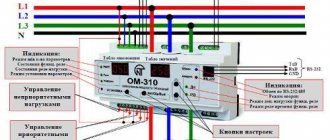What it is
Today, saving energy is an extremely pressing issue. A large number of devices are produced that use the latest technologies, which make it possible to save electrical energy without losing quality. In addition, progress has also affected measuring devices.
Household wattmeter
A household wattmeter is a device designed to measure the power that is consumed by an electricity receiver at home and does not require a special switching circuit. Unlike electric meters, which measure the power used in apartments (houses), a wattmeter is capable of measuring power at any point in the home.
Important! The device in question functions as accurately as an electric meter. The difference will be a finer breakdown of information for a specific consumer.
The main areas of application of wattmeters are industrial sectors in the electrical power industry, mechanical engineering, and repair of electrical devices. In addition, such devices are often used in domestic settings. They are purchased by electronics specialists, computer specialists, and radio amateurs to calculate energy savings.
Wattmeters are used to:
- Calculate the power of devices.
- Conduct tests of electrical circuits and certain parts of them.
- Test electrical installations as indicators.
- Check the operation of electrical equipment.
- Keep records of energy consumption.
Household wattmeters in an outlet do not require special connection diagrams. When the electric meter shows the total power in the home, such devices reflect the operation of all outlets separately. Their device provides a plug for connecting to an outlet and a socket to turn on the load.
Device design
Characteristics of wattmeters
A number of models have holes for accumulators and batteries, which will be required if functions for storing measured parameters and analysis and comparison of data are provided.
Typically, the technical characteristics of the devices are as follows:
- rated power - 3.6 kW;
- current - 16A;
- voltage - 190 - 270 V;
- frequency - 50 Hz;
- minimum measured power - 0.1 W;
- measurement accuracy - error up to 1%;
- total reflected energy consumption - up to 10,000 kW/h;
- own energy consumption - less than 0.5 W;
- The optimal ambient temperature is 5 – 40 degrees.
Most often, using wattmeters in sockets with a power consumption indicator, the operation of kettles, washing machines, heaters, and other household appliances is assessed.
Technical specifications
In accordance with the specified technical parameters, the device is extremely useful for home use and makes it possible to evaluate the voltage in the electrical network, current, load power and electricity consumption.
Measuring ranges:
- operating and test voltage: 80~260VAC;
- measured current: 0-20A;
- operating frequency (in the mains): 50-60 Hz;
- measured power: 0-4500W;
- electricity consumption: 0-9999 kWh (displays how much electricity is consumed by an electronic device connected to such a device in 60 minutes);
- operating ambient temperature indicators: 0-50 degrees;
- the indicated dimensions of 8.5 by 5 by 2.5 cm will correspond to real parameters.
Important! In addition to power, such a device is capable of measuring voltage, electric current, and frequency. Other capabilities of wattmeters will depend on the manufacturing company.
Fixture parameters
Advantages and disadvantages of a wattmeter
The benefits include:
- option for use in DC and AC circuits;
- DC calibration option;
- sufficient stability of readings;
- high accuracy.
The disadvantages include:
- exposure to external electromagnetic fields and mechanical impact;
- significant power consumption.
Having studied all the advantages and disadvantages of the device, it is possible to make the right choice of device.
Kinds
Initially, you need to measure the voltage, then the current, and then, based on the indicators, the power. Taking into account their purpose, the following types of wattmeters are distinguished:
- Power meter. Used to calculate the number of watts in the optical or radio range.
- Kilowatt meter. Used in the process of measuring large parameters (approximately 100 kV).
- Milliwatt meter. To measure small indicators (less than one).
- Varmeter. It shows the reactive power of an electrical circuit.
- Wattvarmeter. Makes it possible to find out information about active and reactive power in an AC electrical circuit.
You may be interested in this Features of the voltage indicator
Based on the type of measurement, conversion of indicators and obtaining information, the devices under consideration are divided into digital and household.
Digital
The basis for the functioning of a digital wattmeter is general measurements. For these purposes, the following is installed at the input: in series with the load - a current indicator, in parallel - a voltage indicator. They are made on the basis of thermistors, special transformers, thermocouples and others.
Instantaneous readings of the measured values will be transmitted to the integrated processor using a digital converter. Here the required measurements will be made and displayed as final data on the monitor and connected external devices.
Digital device
Domestic
The most popular and accurate household wattmeters are electrodynamic system devices.
The operating principle involves the interconnection of 2 coils. One is stationary and has a thick winding with a small number of turns. The other will be movable, the winding is made of thin wire. It has a large number of turns, so the resistance will be high.
It is connected in parallel to the load and is equipped with an auxiliary resistance (to prevent short circuits).
When the device is connected to the electrical network, electromagnetic fields are formed in them. During the interaction, a rotation is created that deflects the moving coil with the connected arrow to a specific angle.
Home appliance
The essence of how analog devices work
If we talk about analog-type devices for measuring power, then the devices of the electrodynamic system have become the most accurate and frequently used.
The operating principle of this power meter is based on the operation of two coils. One of them is characterized by the fact that it does not move, its resistance is low, as is the number of turns. But the winding, on the contrary, is quite thick. The second copy is the opposite of the first. That is, the coil moves, the thickness of the winding is low, but the number of turns is quite large, which is why the resistance is also increased. This device is connected in parallel to the load. In order to avoid a short circuit between the internal coils of the device, the device is equipped with additional resistance.
What does it measure?
The question often arises as to what power the wattmeter will show. Using the device in question, it is possible to measure the used power of virtually all devices in the home. When measuring, it is necessary to take into account the rated power of the device where measurements are taken so as not to damage the wattmeter. This will make it possible to save electrical energy by turning off or reducing the operating time of household appliances. Now it will be known how much electricity, for example, a TV consumes and it is more often disconnected from the network. In addition, it is possible to measure the peak loads of electricity consumers and the power factor of the power grid.
In addition, it is possible to set electricity tariffs to obtain the price of electricity used for a certain period. It is quite comfortable when the user needs to save money, since the device shows how much it will cost to use a particular device.
Device operation
Household appliances
Today, a wattmeter has become a fairly common and convenient device in everyday life, with which you can measure the consumption of electrical energy in the house. This model is a portable version of the device, with which power is measured in a separate area. Thanks to this, it becomes possible to calculate the material costs that will be spent on electricity if the network is left operating with the same parameters.
This device is quite convenient if you need to plan the expenditure of funds, and will also help to optimize certain sections of the home chain.
How to connect
The accuracy of the information received depends on the correct connection of the wattmeter in a specific part of the electrical circuit. The proper connection diagram for a wattmeter will look like this: the stationary coil of the wattmeter is connected in series to the load or electricity consumers.
The moving coil is connected with an auxiliary resistance, and then the entire section is connected in parallel to the load. The movable section of the device in question has a certain rotation angle.
Since the circuit uses additional resistance, the electrical circuit of the device has virtually constant resistance. Power is determined directly by this indicator.
In such a device, a measurement scale is uniformly applied, which is made in a 1-sided version, when the position of the divisions continues from 0 to the right. When the electric current changes its own direction, this leads to changes in the direction of rotation and rotation of the active coil. When the device in question is connected incorrectly and the direction of the current is different, the electrical device will not work.
You might be interested in checking amperes with a multimeter
Because of these factors, the clamps used for connections should not be confused. The series winding has a clamp that connects to the power source. A parallel electrical circuit is called a generator circuit; it has its own terminal for connecting a fragment to a wire that is connected to a series coil.
Important! When properly connected, the currents in the wattmeter coil from the generator terminal are directed to the non-generator terminal.
Connecting a wattmeter
Terms of use
Several different wattmeters are known, most of the devices are designed to carry out similar measurements. However, you need to find a device that plugs into a wall outlet (the easiest method for determining exactly how much electricity a particular device uses). It is possible to use analog and digital wattmeters. Purchasing digital devices will allow consumers to obtain accurate information, while analog devices will require users to carry out very simple calculations to determine watt consumption.
The digital device is connected to the mains. It is necessary to make sure that the device will display the indicator “0” and will be cleared of the last measurements. Next, connect any home appliance to a wattmeter to obtain power readings. When the wattmeter is digital, the fixture usually only needs 5 seconds to calculate the reading. Such fixtures will display the number of watts used by the device over a 60-minute period.
When the meter is analog, you need to look at the spinning disks in it. A stopwatch is used to determine the amount of time required to fully rotate the discs. Next, the kilowatt data shown by the wattmeter is taken, multiplied by 3600 and divided by the number of seconds during which the device rotates. This will be the power application rate for 60 minutes. This procedure is repeated on any devices to evaluate electrical appliances in the home.
Using the device
Persons who want to obtain more accurate data on the total energy consumption in their own home can call electricians (they install a high-performance wattmeter). Such a device will provide detailed data on the price and use of electricity throughout the home, such as which parts of the home use the most electricity. Such meters are intended to help home owners. Thanks to them, it is possible to reduce your own expenses on electrical energy without conducting individual tests on all household appliances separately.
The information obtained using a wattmeter makes it possible to significantly save money. By spending an adequate amount on the purchase of the device in question, the user receives complete information about the effectiveness of the functioning of home appliances.
How to use a multimeter?
Before measuring the voltage in an outlet with a multimeter, let's figure out how this device works. We’ll also look at the quantities it can measure.
Analog multimeter
Multimeters can be analog or digital. The answer to the question of which one is better is obvious - a digital device. After all, digital multimeters always indicate the exact value of the measured value, are tolerant of incorrectly connected probes, and are not so demanding on operating conditions. At the same time, there is only one argument in favor of analog devices - price.
Digital multimeter
That is why in our article we will look at a digital multimeter. Let's start our review with multimeter probes. To connect them, a conventional device has two or three sockets.
So:
- The black probe must be connected to the “COM” socket , which is negative or ground. It depends on the quantity being measured.
Connecting multimeter probes
- The red probe is connected to one of the two remaining sockets . The abbreviation “VΩmA” means that this socket is designed to measure voltage, resistance and current, but only at small values. To measure a current of 1A or more, use a 10ADC socket, which has a more powerful contact part.
Designation of quantities measured by a multimeter
Now let's talk about the quantities that a regular digital multimeter can measure. The designation of some quantities may differ among different manufacturers, so we will present all possible options.
So:
- To measure DC voltage, the limit designated DCV should be used. Within this limit there are usually several positions for voltage measurements from 200mV to 1kV. To measure AC voltage, use the limit designated ACV. It usually also has several positions for measurements from 100V to 1000V.
- The DCA limit is intended for measuring currents. It also has several positions of several hundred microamps, up to several hundred milliamps. In addition, there is usually a provision for measuring current up to 10A. But to connect the device to this position, the instructions advise moving the red probe to the appropriate socket. This is necessary so that the current of 10A is quite large and the weak contacts of the “VΩmA” socket will simply burn out from it.
- To measure the resistance of a circuit, we have a limit "Ω". It has several positions for measuring values from 200Ω to 2MΩ.
Note! Any quantity can be measured using a larger limit. For example, a voltage of 100V can be measured not at the 200V position, but at the 1000V position. But as the measurement limit increases, the instrument error also increases. In this regard, the obtained measurement results may not be reliable enough.
In addition to these basic quantities, many devices have additional limits for measuring the current gain of the transistor, testing for short circuits, measuring diode parameters, and some others. These limits are already more narrowly focused and we will not consider them in more detail.
Alternative symbols on the multimeter
Design
Before purchasing a product, you need to research the device and understand the principle of operation of the wattmeter. Household wattmeter includes:
- DT, DN - current and voltage indicators;
- ADC—digital converter, using an analog signal, it is converted to digital;
- microcontroller - the signals received from the indicators are processed according to a certain algorithm, after which the information is sent to the monitor;
- monitor - the received information will be displayed on it;
- SV is a tool that enters data and allows a person to set parameters in order to obtain the necessary information;
- I is the current that flows through the wattmeter;
- Uin - input voltage;
- Uout is the output voltage of the wattmeter.
Device design
Best models
There are a large number of such measuring instruments on the market from European and domestic manufacturers. Each of them has its own advantages and disadvantages. It is necessary to study the most popular models in detail.
You might be interested in Current clamp meters
ROBITON PM-1
A device that helps control the consumption of electrical energy from the electrical network by 1 consumer. It combines in one housing a plug, a socket, an electrical unit and a monitor that reads the received data.
Makes it possible to calculate the power of a single load connected through the device. The wattmeter determines the amount of energy used over a specific time period and calculates the price of the electricity used.
Pros:
- compact size, simplicity, reasonable price;
- ability to work with any household devices;
- the ability to determine the amount of energy that is consumed by the heater.
Minuses:
- zeroing is poorly thought out;
- only works in warm conditions.
ROBITON PM-1
HiDANCE 3680W AC Power Meter
Compact household electronic device with advanced functionality. Makes it possible to determine the strength of alternating current voltage. Power consumption and its coefficient are calculated.
There is a function for determining the price of energy used. The device is convenient when testing household appliances, electrical appliances and heaters of any type in order to calculate economic efficiency.
Pros:
- bright design, neat assembly of the digital device;
- high-precision measurements, the result is clearly displayed;
- a large number of modes.
Minuses:
- it is necessary to enter the cost again after resetting the information;
- welded fork pins.
HiDANCE 3680W AC Power Meter
Espada TSL 1500WB
An easy-to-learn and use wattmeter that tests household appliances based on the level of energy consumed. Extremely convenient for checking electricity consumption when choosing a heater. The device shows the real power, expenses and price of electricity in the shortest period of time.
Helps calculate thermal efficiency and costs throughout the heating season. There is an option to enter information for a 2-tariff meter. The product signals an emergency situation or excess current or power.
Pros:
- high-precision product, measurement speed;
- the monitor is illuminated, large numbers;
- electricity price calculation.
Minuses:
- inconsistent backlight;
- Difficult to change power source.
Espada TSL 1500WB
TP-Link HS110
The device controls and takes measurements at a distance via a network using a smartphone or other electrical device. There is an option to automatically connect or turn off energy consumers.
Monitoring over a distance of electricity consumption makes it possible to select the appropriate mode of operation of household appliances or heating systems. A wattmeter helps set the required power.
Pros:
- remote control option;
- compact size, works with any household appliance;
- adequate cost.
Minuses:
- sensitivity to network quality.
TP-Link HS110
Device functions
In addition to the usual indicators, this device is also capable of recording values such as peak power and peak current. In addition, there are several other functions. The device also shows the current time and can work like a regular real-time clock. Another possibility of using the device is an audible alarm, which will sound if the device begins to consume more power than the user sets manually.
The buttons on the device can be used to manually configure the device's operating functions. It is possible to set the maximum permissible radiation power, set the cost per kilowatt per hour, etc.
In terms of operation, this device is very simple. For it to work, you need to connect it to the network, that is, plug it into an outlet. Next, you need to connect the plug of the device under study to this household wattmeter. All parameters of the connected device will be displayed automatically.
Among the main parameters of this device, one can highlight the fact that almost any household appliance can be connected to it. The total maximum power of devices should not exceed 3600 W. Also, the current rating must not exceed 16 A.
